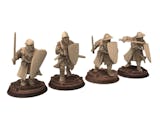Printed in solid non-hollowed resin (no holes).
Good quality resin (40€/kg).
Bases not supplied.
Randomly packaged.
28mm scale (for Saga/Lotr/D&D).
These models were made by Medbury miniatures and are sold under license.
https://www.patreon.com/medburyminiatures/posts
During the Middle Ages in Europe, the term "men-at-arms" referred to heavily armed and armored soldiers who fought on horseback or on foot. These soldiers were typically members of the nobility or landed gentry and were expected to provide their own armor and weapons. Over time, the role of the men-at-arms evolved as warfare changed. During the Scottish Wars of Independence, for example, men-at-arms were used primarily to charge enemy lines and break them apart. This required strength, agility, and skill with a lance or sword. In contrast, during the Hundred Years' War, men-at-arms often fought dismounted with polearms, such as the halberd, which were effective against heavily armored knights.
The role of men-at-arms continued to evolve throughout the Middle Ages. As warfare became more complex, they became more specialized, with different types of men-at-arms being trained for specific tasks. Knights, for example, were trained in mounted combat and heavy cavalry charges, while sergeants were trained in infantry tactics and the use of ranged weapons like the crossbow.
During the War of Independence in Scotland and the Hundred Years War, men-at-arms played a crucial role in many of the most famous battles. At the Battle of Agincourt in 1415, for example, the English men-at-arms, including heavily armored knights and archers, defeated a much larger French force through a combination of superior tactics, discipline, and sheer force of arms.
In addition to their martial prowess, men-at-arms were often expected to serve as personal attendants to their lords and masters, performing a variety of duties both on and off the battlefield. They were responsible for maintaining their own equipment, including weapons, armor, and horses, and often served as messengers, scouts, and guards.
The equipment of men-at-arms also changed over time. In the early Middle Ages, they wore chain mail and carried swords and shields. Later, plate armor became more common, which provided better protection against arrows and other missiles. They also began to use more specialized weapons, such as the longbow, which allowed them to strike from a distance. The introduction of gunpowder weapons in the late Middle Ages further changed the role of men-at-arms, as they became more vulnerable to firearms and had to adapt their tactics accordingly.
Today, men-at-arms continue to hold a place of honor in the world of wargaming and miniature gaming. Their historical significance, combined with their iconic look and feel, make them a popular choice for players and collectors alike. Whether you're playing a game of historical wargaming or a fantasy RPG, having a collection of men-at-arms miniatures is an essential part of the experience. So if you're a fan of medieval history or gaming, be sure to add some men-at-arms to your collection and experience the thrill of medieval warfare for yourself.
If you are a wargamer interested in medieval history, then having miniature figures of men-at-arms is essential for recreating historical battles. Many wargaming companies offer a wide range of men-at-arms figures, allowing you to create accurate representations of armies from different periods. But men-at-arms are not only useful for historical wargaming. They are also great for fantasy wargames, such as Dungeons & Dragons, where they can be used as heavily armored knights or paladins. So whether you are a historical wargamer or a fantasy enthusiast, men-at-arms are a must-have for your miniature collection.
Here is the list of battles of the Hundred Years' War and the Scottish War of Independence:
Battle of Stirling Bridge (1297)
Battle of Falkirk (1298)
Battle of Bannockburn (1314)
Battle of Dupplin Moor (1332)
Battle of Halidon Hill (1333)
Battle of Neville's Cross (1346)
Battle of Otterburn (1388)
Battle of Sluys (1340)
Battle of Crecy (1346)
Battle of Poitiers (1356)
Battle of Najera (1367)
Battle of Montiel (1369)
Battle of Auray (1364)
Battle of Roosebeke (1382)
Battle of Otterburn (1388)
Battle of Agincourt (1415)
Battle of Patay (1429)
Battle of Formigny (1450)
Battle of Castillon (1453)




















